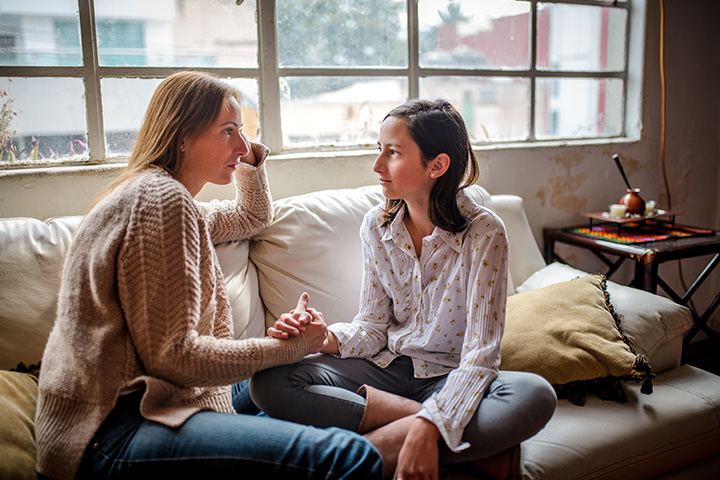
Image: Shutterstock
Parents often give in to the demands of their young children to be on social media to avoid unnecessary arguments, temper tantrums, or drama at home. However, as much as you care about your child’s physical health, know that neglect or carelessness in protecting them from cyberbullies and inappropriate content on the internet can drive their mental wellbeing to the backseat.
As the world has embraced technology today and social media platforms have become part and parcel of everyday lives, keeping an eye on your child’s internet habits can help you keep them safe and protected online. How vigilant are you in protecting your kid from trolls, predators, and inappropriate content? Here are five best practices to adopt to introduce cyber safety measures in your parenting toolkit and minimize the risk of online child abuse:
1. Start A Healthy Conversation About Internet Safety
Image: IStock
It’s essential to have an open-ended conversation with your child about the dangers of social media and how to maintain their privacy. Speak with them about befriending known contacts and avoiding or blocking those they have never interacted with in real life. While you may consider it appropriate to scan and scrutinize their friend list, it’s best to develop some trust with your child first before you barge into their social media accounts. This will also allow you to create a trusted space for your child to reach out to you when they sense danger or fear being harassed online.
2. Set Clear Rules To Follow
Image: Shutterstock
It’s best to establish rules that your kids must follow if they are to use social media. So, instead of trying to sneak into their profile, ask them to show it to you whenever you are wary of their safety. Make it known to them that secret passwords for their social media accounts and devices are not allowed, at least until they are mature enough to lead an independent life. Ask them questions about what they read, watch, share, or contacts they chat with over social media platforms. Seek access to their email accounts and befriend them on their profiles. Periodically check their passwords or purchase a parental control application if you are firm on monitoring their social media usage. Always keep the communication clear and transparent so that they know the consequences of not following these rules you have mutually agreed upon.
3. Practice What You Preach
Image: Shutterstock
While you may be tempted to impose orders on your child, it’s always a good idea to lead by example. Remember, they will follow in your footsteps and behave accordingly. If you embarrass, shame, or bully others, they will do the same. So, your conduct on social media matters if you wish to teach your kids the right way to use social media. Be careful of what you share, discuss, and consume on social media. Regularly check your privacy settings and keep your location history turned off as smartphones can detect it. Lack of adequate privacy settings could not only jeopardize your safety but your child’s too.
4. Educate Them About The Unreal Side Of Virtual Reality
Image: Shutterstock
With the entire population hooking on to the digital space, the dangers are irrefutable. Researchers have confirmed a strong link between social media interactions and children’s stunted social development. Children and adolescents are increasingly falling prey to depression, addictions, loneliness, and anxiety due to internet browsing and social networking activities. In the long run, these contribute to low self-esteem and reduce real-world interaction in children and teenagers (1).
Hence, it is crucial to make your child aware of the pros and cons of using social media. Tell them that the virtual world is not an honest reflection of what happens in real life. It’s a smokescreen, and people rarely post images, videos, or information about their struggles and imperfections. What we see is just a tiny part of who these people are. Fake profiles have infected the virtual space. Therefore, practicing caution can save them from upsetting situations or events. Teach them to take the virtual world with a pinch of salt. It’s the best way forward and an excellent recipe for minimizing expectations and maximizing happiness.
5. Encourage Them To Reach Out To You
Image: IStock
As long as your child knows that you are there for them and they can reach out to you at their convenience, it’s all good. Your child will make mistakes, and that’s just part of growing up and learning their lessons, sometimes, the hard way. If they fear being abused or exploited, make it known that they should inform you. This could ensure that things do not escalate to a dangerous breaking point.
When your child goes online unsupervised, they could be at the receiving end of harmful content as online and offline bullying is a harsh reality that we cannot escape. So, as parents, maintaining some vigilance is crucial for securing their online presence. It may not be easy in the beginning to convince your child about keeping it transparent, but you can handle it well if you are tactful, patient, and open to gaining their confidence amicably. How have you ensured the highest safety for your child on the internet? Do share your stories with us in the comments section below!

















